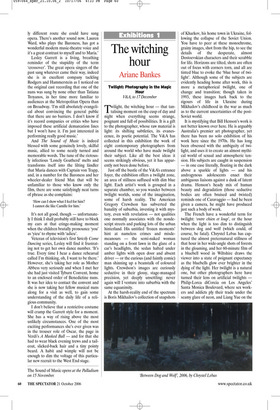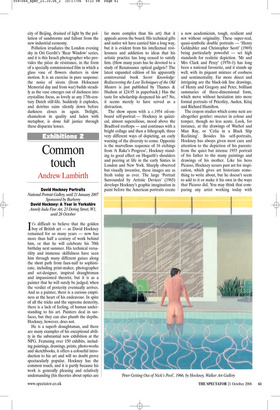The witching hour
Ariane Bankes
Twilight: Photography in the Magic Hour
V&A, to 17 December
Twilight, the witching hour — that tantalising moment on the cusp of day and night when everything seems strange, poignant and full of possibilities. It is a gift to the photographer, whose raw material is light: its shifting subtleties, its evanescence, its poetic potential. The V&A has collected in this exhibition the work of eight contemporary photographers from around the world who have made twilight their subject. Like all the best ideas it seems strikingly obvious, yet it has apparently not been done before.
Just off the bustle of the V&A’s entrance foyer, the exhibition offers a twilight zone, an area of stillness suffused with dim blue light. Each artist’s work is grouped in a separate chamber, so you wander between twilight worlds, some of the imagination, some of harsh reality. The American Gregory Crewdson has subverted the banality of suburbia, investing it with mystery, even with revelation — not qualities one normally associates with the nondescript streets and parking lots of the urban hinterland. His untitled ‘frozen moments’ hint at nameless crimes and misdemeanours — the semi-naked woman standing on a front lawn in the glare of a car’s headlights, the sedan halted under amber lights with open door and absent driver — or the curious (and faintly comic) man shinning up a beanstalk of coloured lights. Crewdson’s images are curiously seductive in their glossy, stage-managed precision, yet deeply unsettling: never again will I venture into suburbia with the same equanimity.
At the harsh-reality end of the spectrum is Boris Mikhailov’s collection of snapshots of Kharkov, his home town in Ukraine, following the collapse of the Soviet Union. You have to peer at these monochrome, grainy images, shot from the hip, to see the details of the desperate, almost Dostoevskian characters and their scrabble for life. Horizons are tilted, shots are often out of focus with corners torn, and all are tinted blue to evoke the ‘blue hour of twilight’. Although some of the subjects are evidently heading home after work, this is more a metaphorical twilight, one of change and transition; though taken in 1993, these images hark back to the rigours of life in Ukraine during Mikhailov’s childhood in the war as much as to the current uncertainties of the postSoviet world.
It is mystifying that Bill Henson’s work is not better known over here. He is arguably Australia’s premier art photographer, yet there has been no solo exhibition of his work here since the 1970s. He has long been obsessed with the ambiguity of twilight, and uses it to create an almost mythical world of sexual and atmospheric tension. His subjects are caught in suspension — in one case literally, floating in the dark above a sparkle of lights — and his androgynous adolescents enact their ambiguous liaisons against a dusk of latent drama. Henson’s heady mix of human beauty and degradation (those seductive bodies are often bruised and twisted) reminds one of Caravaggio — had he been given a camera, he might have produced just such a body of work.
The French have a wonderful term for twilight: ‘entre chien et loup’, or the hour when the light is too dim to distinguish between dog and wolf (which could, of course, be fatal). Chrystel Lebas has captured the almost preternatural stillness of that hour in her wide-angle shots of forests in the gloaming, and her 60-minute film of a bluebell wood in Wiltshire draws the viewer into a state of poignant expectancy as the bluebells glow ever brighter in the dying of the light. Her twilight is a natural one, but other photographers here have turned their lens on artificial twilights Philip-Lorca diCorcia on Los Angeles’ Santa Monica Boulevard, where sex workers and addicts ply their trade under the seamy glare of neon, and Liang Yue on the city of Beijing, drained of light by the pollution of sandstorms and fallout from the new industrial economy.
Pollution irradiates the London evening sky in Ori Gersht’s ‘Rear Window’ series, and it is this Israeli photographer who provides the pièce de résistance, in the form of a specially commissioned film in which a glass vase of flowers shatters in slow motion. It is an exercise in pure suspense: the noise of sirens (from Holocaust Memorial day and from war) builds steadily as the vase emerges out of darkness into crystalline focus, as lovely as any 17th-century Dutch still-life. Suddenly it explodes, and detritus rains silently down before darkness closes in again. Twilight, chameleon in quality and laden with metaphor, is done full justice through these disparate lenses.



































































































 Previous page
Previous page